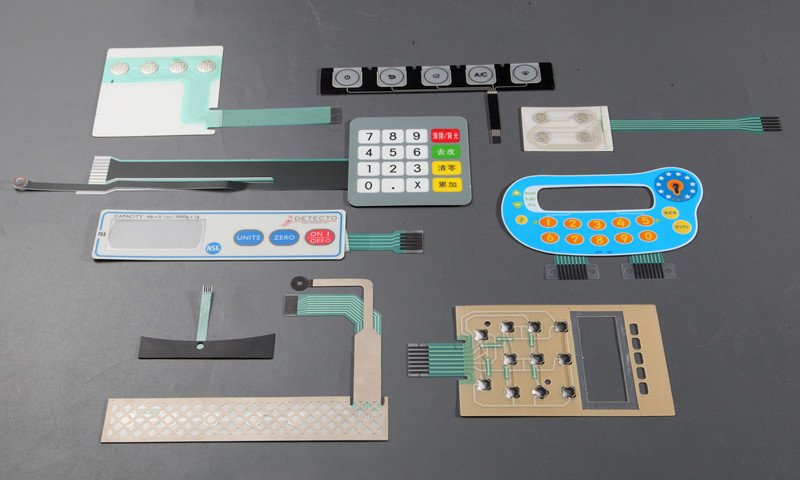Introduction of Printed Membrane Switch
Printed membrane switches have become an integral part of modern electronic devices, ranging from industrial control panels to medical equipment and consumer electronics. Their exceptional durability and reliability are key reasons for their widespread use. In this article, we will explore the factors that contribute to the durability and reliability of printed membrane switches and how they have become a vital component in a variety of industries.
Superior Construction for Enhanced Durability
One of the key reasons printed membrane switches are so durable is due to their construction. Unlike traditional mechanical switches that have moving parts prone to wear and tear, printed membrane switches are built from a single, flexible layer of material. This eliminates the risk of mechanical failure, as there are no moving components to break. Typically made from materials like polyester or polyimide, these switches can withstand exposure to chemicals, moisture, and extreme temperatures, enhancing their durability in harsh environments.
Resistance to Repeated Use
Printed membrane switches are designed to handle repeated use without showing signs of degradation. In contrast to mechanical switches that can wear out after a specific number of cycles, these membrane switches retain their functionality even after thousands of uses. The flexible design allows the membrane to flex and return to its original shape, preventing mechanical failure. Additionally, many switches are designed to resist scratches and abrasion, ensuring their longevity in high-traffic areas.
Withstanding Harsh Environments
Another significant factor in the reliability of the membrane switches is their resistance to environmental factors. Whether exposed to chemicals, moisture, or extreme temperatures, these switches continue to perform reliably. For example, in the medical field, these switches are exposed to disinfectants and cleaning agents, yet they maintain functionality. In industrial settings, printed membrane switches are used in control panels where they face dust, moisture, and temperature fluctuations.
Cost-Effectiveness and Customization
The membrane switches are not only durable and reliable but also cost-effective to produce. This affordability makes them an attractive choice for manufacturers aiming to reduce production costs. Additionally, they are easy to design and manufacture, which allows for rapid prototyping and quick turnaround times in production. Their flexibility also extends to customization, as they can be tailored to meet specific requirements, including various sizes, shapes, and colors.
Advancement in Capacitive Touch Technology
The development of the membrane switches has paved the way for new technologies, such as capacitive touch switches. These switches detect touch through a capacitive sensor, eliminating the need for physical contact. This technology has transformed the way users interact with electronic devices, making touch-sensitive interfaces both functional and aesthetically pleasing. The durability and reliability of the membrane switches have been crucial in driving the development of these innovations.
Conclusion of Printed Membrane Switch
In summary, the durability and reliability of printed membrane switches have made them an ideal solution for various industries. Their robust construction, environmental resistance, and capacity to withstand repeated use ensure their long-lasting performance. As technology advances, the membrane switches will continue to play a pivotal role in the development of new, innovative products. Their cost-effectiveness, flexibility, and contribution to emerging technologies further solidify their importance in modern electronics.
FAQ: Durability and Reliability of Printed Membrane Switches
1.What are printed membrane switches?
They are flexible electrical components used in various electronic devices like industrial control panels, medical equipment, and consumer electronics. They function as user interfaces for controlling devices.
2.Why are printed membrane switches considered durable?
Their durability stems from their construction. Unlike mechanical switches with moving parts that can wear out, the membrane switches consist of a single, flexible layer of material, often polyester or polyimide, which withstands harsh environments, chemicals, moisture, and extreme temperatures.
3.How reliable are printed membrane switches?
They are highly reliable due to their ability to withstand repeated use. These switches are designed to flex without degrading, allowing them to perform for thousands of cycles without mechanical failure.
4.Can printed membrane switches be used in harsh environments?
Yes, they are designed to resist exposure to environmental factors like chemicals, dust, moisture, and extreme temperatures, making them suitable for industrial, medical, and other demanding applications.
5.Are printed membrane switches cost-effective?
Yes, they are relatively inexpensive to produce, making them a cost-effective option for manufacturers. They are also easy to design, which allows for rapid prototyping and customization.
6.Can printed membrane switches be customized?
Yes, they can be customized in terms of size, shape, and color to meet specific requirements for different applications.
7.What role do printed membrane switches play in capacitive touch technology?
They have contributed to the development of capacitive touch switches, which detect touch without physical contact, leading to more intuitive and user-friendly touch-sensitive interfaces.
8.What industries benefit from printed membrane switches?
Industries such as medical equipment, industrial control systems, and consumer electronics benefit from the durability, reliability, and flexibility of printed membrane switches.
9.How do printed membrane switches compare to traditional mechanical switches?
They are more durable and reliable than traditional mechanical switches, which have moving parts that wear out over time. The printed version lacks moving parts, reducing the risk of mechanical failure.
10.What is the future of printed membrane switches?
As technology evolves, the membrane switches are expected to play an increasingly important role in developing new and innovative electronic products. Their combination of durability, cost-effectiveness, and customization options ensures continued relevance in various industries.

